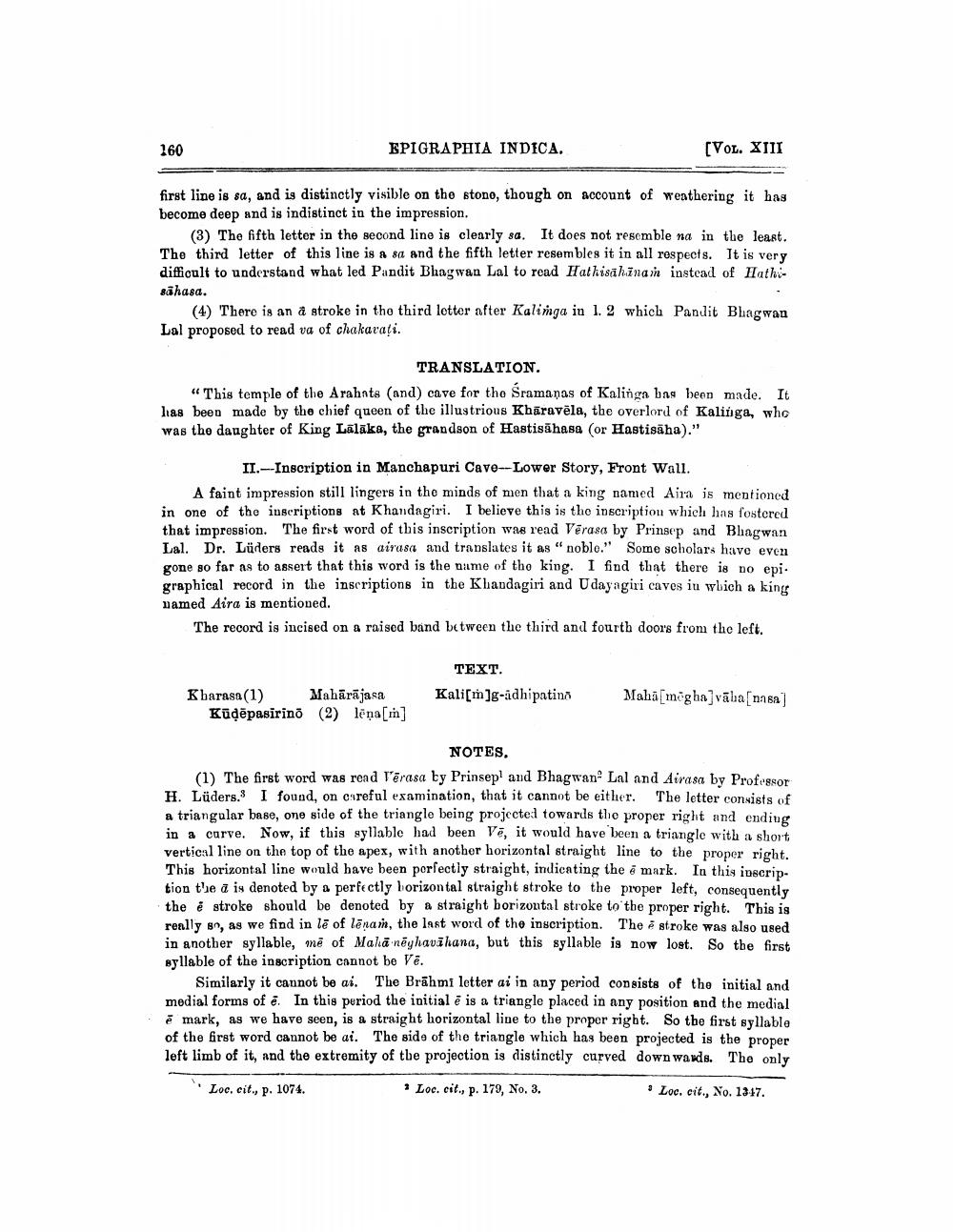________________
160
EPIGRAPHIA INDICA.
[VOL. XIII
first line is sa, and is distinctly visible on the stone, though on account of weathering it has become deep and is indistinct in the impression.
(3) The fifth letter in the second line is clearly sa. It does not resemble na in the least. The third letter of this line is a sa and the fifth letter resembles it in all respects. It is very difficult to understand what led Pandit Bhagwan Lal to read Hatkisahānam instead of Hathsähasa.
(4) There is an a stroke in the third letter after Kalinga in 1.2 which Pandit Bhagwan Lal proposed to read va of chakavați.
TRANSLATION. « This temple of the Arahnta (and) cave for the Sramanos of Kalingn bng been made. It has been made by the chief queen of the illustrious Khāravela, the overlord of Kalinga, who was the daughter of King Lalaka, the grandson of Hastisähasa (or Hastisäha)."
II.--Inscription in Manchapuri Cave--Lower Story, Front Wall. A faint impression still lingers in the minds of men that a king named Aira is mentioned in one of the inscriptions at Khandagiri. I believe this is the inscription which hng fostered that impression. The first word of this inscription was read Vērasa by Prinsep and Bhagwan Lal. Dr. Lüders reads it as airasa and translates it as "noble." Some scholars have even gone so far as to assert that this word is the name of the king. I find that there is no epi. graphical record in the inscriptions in the Klavdagiri and Udayagiri caves in which a king named Aira is mentioned.
The record is incised on a raised band between the third and fourth doors from the left.
TEXT. Kali[m]g-adhipatino
Maha[megbalvāla na sa]
Kharasa(1) Mahārājasa
Kūąēpasirino (2) lēna[m]
NOTES. (1) The first word was rend Vērasa by Prinsep and Bhagwan. Lal and Airasa by Professor H. Lüders. I found, on careful examination, that it cannot be either. The letter consists of a triangular base, one side of the triangle being projected towards the proper right and ending in a carve. Now, if this syllable had been Vē, it would have been a triangle with a short vertical line on the top of the apex, with another horizontal straight line to the proper right. This horizontal line would have been porfectly straight, indicating the 2 mark. In this inscription the ais denoted by a perfectly horizontal straight stroke to the proper left, consequently the è stroke should be denoted by a straight borizontal stroke to the proper right. This is really so, as we find in lē of lēnam, the last word of the inscription. The stroke was also used in another syllable, mē of Malā nēyhavihana, but this syllable is now lost. So the first syllable of the inscription cannot be Ve.
Similarly it cannot be ai. The Brāhmi letter ai in any period consists of the initial and medial forms of e. In this period the initial é is a triangle placed in any position and the medial i mark, as we have seen, is a straight horizontal line to the proper right. So the first syllable of the first word cannot be ai. The side of the triangle which has been projected is the proper left limb of it, and the extremity of the projection is distinctly curved down ways. The only
Loc. cit., p. 1074.
* Loc. cit., p. 179, No. 3.
• Loc. cit., No. 1317.




